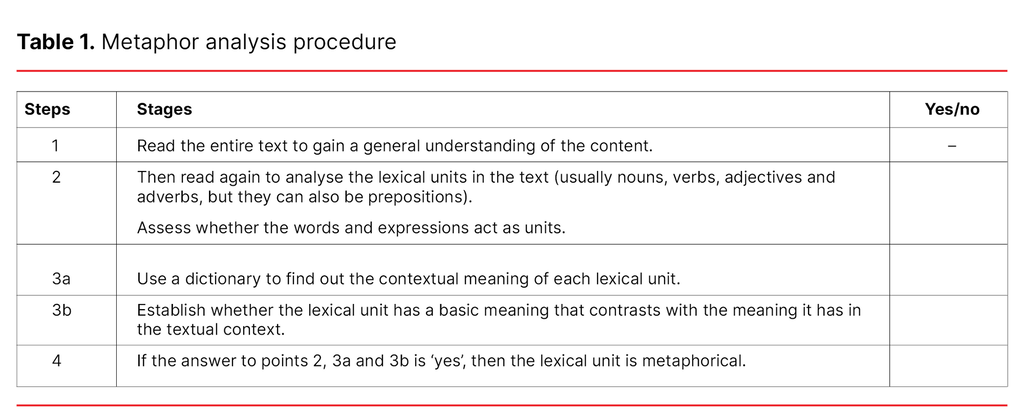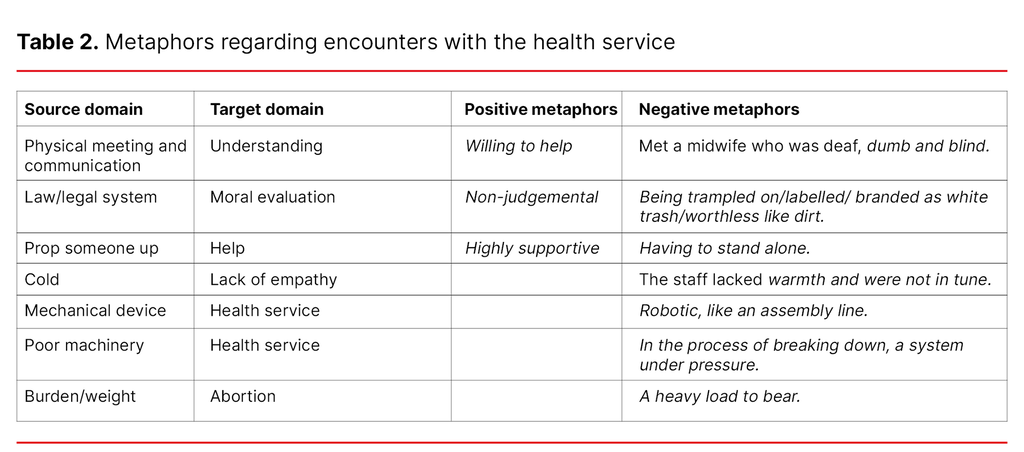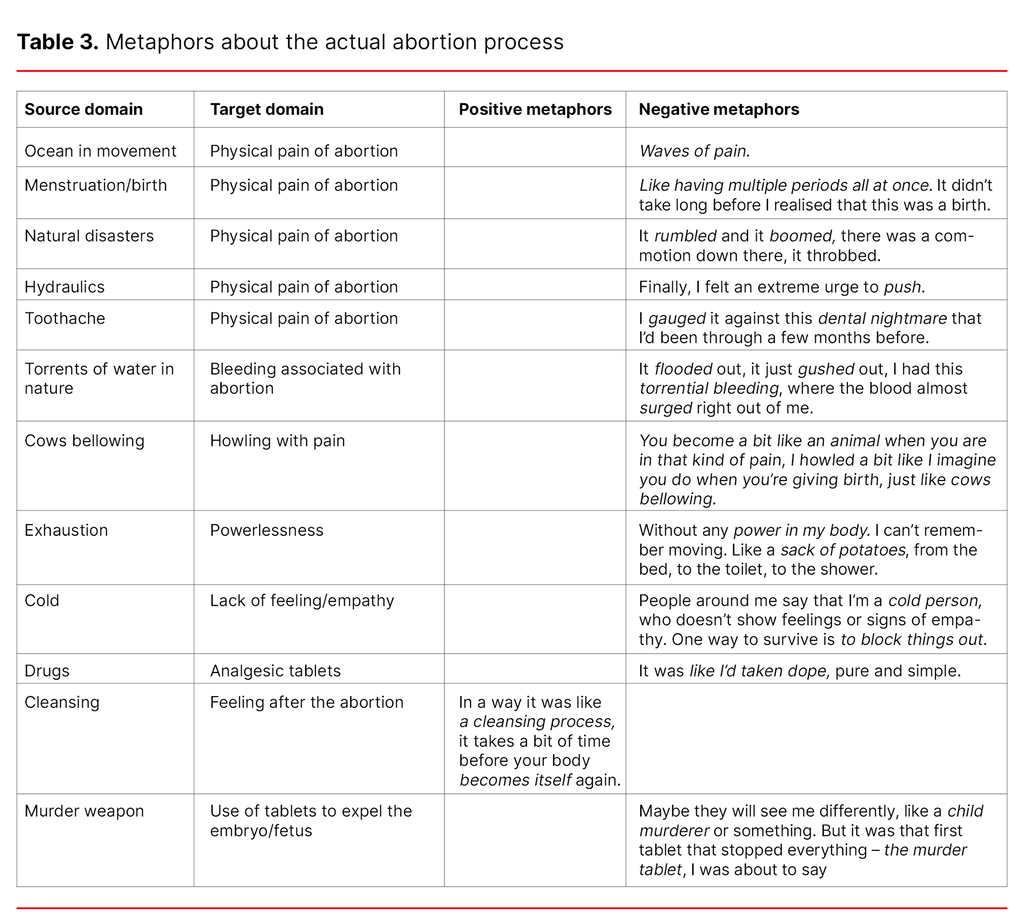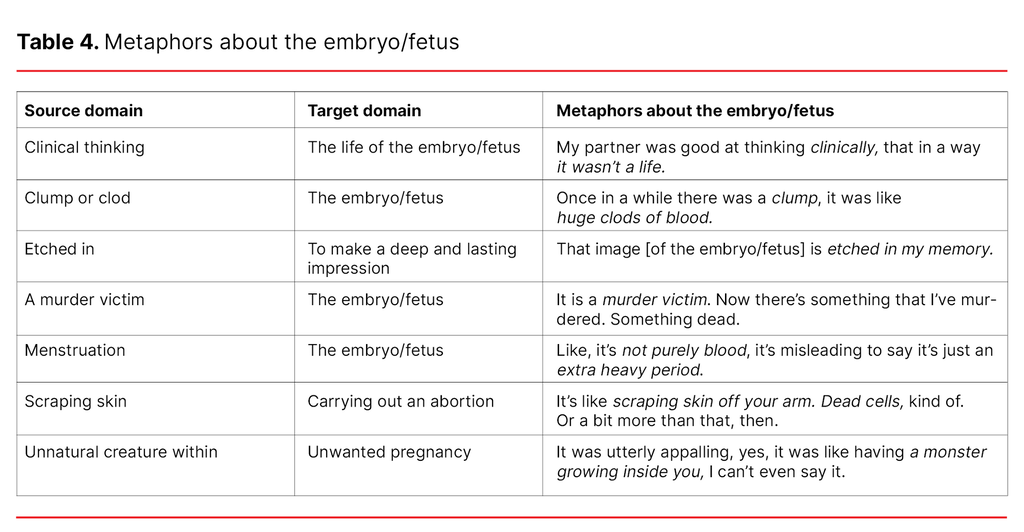‘Not purely blood.’ Women’s use of metaphors in relation to medical abortions
Summary
Background: Metaphors are useful for expressing things that are not directly observable, but nevertheless may be real feelings or bodily experiences. In this study, therefore, we wanted to highlight women’s use of metaphors in relation to medical abortions.
Objective: To study metaphors used by Norwegian women who have carried out medical abortions in their own homes.
Method: This study is a secondary analysis of existing data collected from 24 interviews conducted in 2019–2020. The women were asked about their experiences of carrying out abortion, about their experiences during the process and about the follow-up they received from the health service.
Results: The metaphor analysis showed that women used many different metaphors to describe their experiences. They also used many words to moderate their comments and to signal that they were searching for words. In addition, the metaphor analysis showed that women often felt lonely, ashamed and thus not worthy of health care – feelings they could also struggle with after terminating the pregnancy. It is likely that these feelings were amplified as a result of the lack of follow-up the women received from the health service.
Conclusion: The study demonstrated how metaphors are pathways to messages about existential experiences, especially in relation to feelings and topics that can be difficult to convey due to shame and stigma, and that create a sense of loneliness. These feelings persisted also after terminating the pregnancy. In order to provide adequate, tailored support, healthcare personnel need to be aware of metaphorical messages and take into account women’s different life experiences in relation to carrying out abortions in their own homes.
Cite the article
Askeland N, Johannessen A, Sommerseth E. ‘Not purely blood.’ Women’s use of metaphors in relation to medical abortions. Sykepleien Forskning. 2023;18(91724):e-91724. DOI: 10.4220/Sykepleienf.2023.91724en
Introduction
Elective abortion is regarded as a common right in many countries, including Norway. However, the decision to have an abortion is a complex and complicated one. Abortion is a political issue and the abortion debate is often focused on moral and ethical questions.
The language used can be offensive to women, especially when hard battle lines are drawn on both sides of the abortion debate, as in a recently published article about language use in the debate between pro- and anti-choice lobby groups in Ireland (1) and in the corresponding debate in the United Kingdom (2). The discussions are often focused on feelings and things that are not directly observable.
Studies have shown that metaphors are useful for expressing things that are not directly observable, but nevertheless may be real feelings or bodily experiences (3, 4). In abortion debates, it may be the debaters’ moral judgements that emerge through the use of metaphors.
In the Norwegian context, Merete Flatseth has analysed the principal conceptions of women in the abortion debate. She found that politicians used metaphors such as women’s fractured health and that they described women’s minds as porous objects. According to her evaluation, these metaphors helped to give women sufficient ethical justification to have an abortion (5).
However, few studies have been conducted on women’s own use of metaphors in relation to abortion. There is a particular lack of studies focusing on women’s use of metaphors in relation to medical abortions.
Metaphors are being used increasingly as a ‘tool’ in health service interventions. This study provides an opportunity to explore which metaphors women use about their own experiences of medical abortion (3). A common definition of a metaphor according to the cognitive-behavioural tradition is that it ‘describes something by referring to something else’ (6).
Metaphors can help in understanding patients’ symptoms and reactions, and motivate them to seek care (4, 7). Metaphors are useful for expressing things that are not directly observable, but nevertheless are perceived as real experiences or bodily experiences. Consequently, metaphors can provide insight and information about significant experiences and patients’ need for support and assistance (4, 7–9).
On the basis of other studies (4, 10, 11) on the experiences of patients and their family members, we want to shed light on women’s experiences in carrying out abortions in their own homes.
This study is a secondary analysis of existing data from an article that was published in 2022 (12). Our study is divided into three parts and is structured around the following research questions:
- Which metaphors do women use about their encounters with the health service before and after an abortion?
- Which metaphors are used in relation to the process itself?
- Which metaphors are used to describe the embryo/fetus?
Method
As mentioned, the study is a secondary analysis (13, 14) of existing data from a qualitative study based on individual interviews, conducted in the period 2019 to 2020 (15). The informants were recruited via various relevant channels. The inclusion criteria were that the women must have experienced a medical abortion at home, and the abortion must have been carried out before the twelfth week of gestation.
The sample consisted of a total of 24 informants aged between 24 and 45. The marital status of the informants varied, although this issue was not raised in the interviews. There were representatives from most parts of the country. In this article, a secondary analysis is carried out of existing data in order to study the metaphors women use to discuss their experiences of abortion. Further descriptions of the method are explained in the article by Sommerseth et al. (12).
The interviews
In the study by Sommerseth et al. (12), an interview guide with three open-ended questions was used:
- Can you tell me about your experiences of carrying out a medical abortion?
- Can you tell me about your experiences during the process?
- What kind of follow-up were you given after terminating the pregnancy?
What is a metaphor?
When we use a metaphor, we talk about something by referring to something else (6). A metaphor has two domains: the target domain and the source domain. The target domain is what we are talking about: for example, the feeling of being disparaged. The source domain is what we are comparing it to, for example, dirt.
In the sentence ‘I felt like dirt’, the target domain is the feeling and the source domain is ‘dirt’, that is, the word you are using to describe the feeling. These two terms are useful in the work of identifying metaphors. We can say that a metaphor moves meaning from one meaning context to another.
One method for identifying metaphors (16) is to begin by reading the entire text to gain an understanding of the content. Then the lexical units in the text are analysed, usually nouns, verbs, adjectives and adverbs and, in some cases, prepositions. An assessment is made as to whether the words and expressions act as units. Subsequently, it must be ascertained whether the words have a different meaning in other contexts, and whether this is in contrast to the basic meaning. If the answer is ‘yes’, the words are being used metaphorically.
In carrying out the study, we used the Collins English Dictionary (17), which lists multiple definitions of words and expressions, including metaphorical meanings. For example, when we looked up the word cold, we found this definition: ‘cold weather, low temperature’. One of the definitions that follows is: ‘Unfriendly or unsympathetic attitude’.
Here, we see that the dictionary first provides the literal meaning of ‘cold’ (low temperature), followed later by the metaphorical meaning (unfriendly). When a word has several meanings, the metaphoric meaning comes last as a rule. Table 1 shows the process of metaphor identification in several steps according to Steen et al. (18).
In addition to registering metaphors at word level, we have identified metaphor signals or flags, which are often used to intensify or moderate metaphoric language (16).
Examples of metaphor signals are words such as like, as, compared to, kindof, sort of,actually, quite simply and a bit. These are words that may introduce metaphorical expressions in a sentence, and they may be signs that the metaphors are intended as suggestions or negotiations of meaning. They may also be a sign that informants want to moderate or intensify their language or are searching for words and expressions that can adequately describe their experiences.
Ethics
The study followed the Declaration of Helsinki’s ethical principles (20). It was judged by the Regional Committee for Medical and Health Research Ethics (REK) to be outside their area of responsibility.
The study was approved by the Norwegian Centre for Research Data (NSD) (reference number 22708). The informants received oral and written information about the study and they gave their written consent prior to being interviewed.
Results
Metaphors regarding encounters with the health service
The main metaphors informants used when referring to their encounters with the health service are shown in Table 2. The source domain is the actual area in nature that the reference is taken from, and the target domain is the topic of discussion.
Some of the informants felt that they had been well looked-after and followed up by the health service, by public health nurses, general practitioners and gynaecologists. They were described as willing to help, non-judgemental and highly supportive. They helped informants to see the way ahead and they saw the whole person.
Others commented that they received little understanding or support. One of the most common metaphors in the data was cold. The atmosphere in the women’s encounters with the health service was described as ‘robotic’, ‘clinical’ and ‘ice-cold’.This was in reference to the healthcare system, not healthcare personnel. The system makes it difficult for healthcare personnel to know what to do when someone breaks down completely, as one of the informants expressed it.
The metaphors related to ‘cold’, ‘robotic’, ‘clinical’ and ‘mechanical’ reflect the informants’ sense of feeling small or worthless, like dirt, as another informant expressed it.
The informants emphasised the mechanical aspect of the health service in relation to the abortion being carried out at home, and the perception of the procedure as efficient, or quick in, quick out and businesslike. Others expressed a sense of feeling small and being trampled on when they encountered a doctor who gave them a lecture on contraceptive methods.
The informants highlighted a desire to be met with greater understanding on the part of the health service and had suggestions about what could be done: ‘I wish they could be just a little bit more intune.’ Another informant would have liked an experienced midwife, ‘not one that was deaf, dumb and blind, one that had a sort of warm and kindly manner.’
The most common metaphor signals had a moderating effect, such as like, kind of and in a way, which may be a sign that the informants were searching for the right words to describe complex feelings. Nevertheless, it was clear from the metaphors that some of the informants had felt alone, or had been depressed, and could have benefited from having someone to talk to, but that the prevailing policy did not allow the time or space for this.
As Table 2 shows, the majority of the metaphors were negative, but some also expressed that the encounter with the health service was positive.
Metaphors about the process
The metaphors that relate to the process are documented in Table 3. Here too, the source domain is the actual area in nature that the reference is taken from, and the target domain is the topic of discussion.
The physical pain during the process of removing the embryo/fetus was described in different ways. It was compared to waves, and described as like having multiple periods all at once. When the process began, it was likened to a natural disaster: ‘It rumbled and it boomed, I felt a commotion down there, but nothing was happening. But when it started to throb, things happened fast. Finally, I felt a kind of extreme urge to push.’
The body’s physical exertion to expel the embryo/fetus could be exhausting and was perceived as something they had to steel themselves against. ‘I gauged it against this dental nightmare that I’d been through a few months before. Then I thought: “Okay, I know that this will pass. My body will sort this out.”’
To trust in your body also means surrendering to stronger forces within yourself: ‘Because yes, I did become a bit of a cavewoman.’ The metaphor cavewoman is a strong expression, and the informant had chosen to moderate it by using the metaphor signal a bit. This metaphor is quite primal, and as such, has a connection to birth, and it proved to be the case here: ‘Mmm. Yes, I was completely [...] and it was [...] it didn’t take long [before] I realised that this was a birth.’
Abortion is perceived as something more dramatic than a birth, as recounted by one woman who went to a friend’s house to avoid being alone: ‘No sooner had I arrived at my friend’s place than it flooded out.’ This abortion proved to be a bloody and dramatic affair: ‘It just gushed out and, afterwards, there was nothing left. And because there was such a lot, then I knew there must be something wrong.’
The informant in question proved to be correct in her assessment of something being wrong: ‘It was in my body for six weeks before I had this torrential bleeding, where it almost, where the blood almost surged right out of me.’ The metaphor torrential bleeding is a compound noun, which is common to many metaphors. Here, it is implicit that the flow of blood is compared to a torrent.
When the pain during the process was described, the informants used metaphors related to animals: ‘You become a bit like an animal when you are in that kind of pain, yes, or I howled a bit like I imagine you do when you’re giving birth, just like cows bellowing.’
The powerful animal metaphor and the comparison to cows was expressed together with the metaphor signals a bit like and just like, in which the first toned down the metaphor, while the other intensified it. The metaphors highlighted the exhausting aspect of the process, as this woman described it: ‘Without any power in my body. I can’t remember moving. Like a sack of potatoes, from the bed, to the toilet, to the shower.’
The metaphors also described how the body was put into a state of preparedness in order to cope, and the cold metaphor cropped up again: ‘I can take quite a lot, I’m a cold person. People around me say that I’m a cold person, who doesn’t show feelings or signs of empathy. That’s what they say. And that’s the way it is. One way to survive is to try not to remember what has happened. So it was kind of blocked out. Blocked out, yes.’
The fact that it was difficult to remember what had happened may also be connected to the medication. The women recalled that the hospital staff gave them analgesic tablets to take home with them, and that they were stronger than the usual painkillers: ‘So, there was this dope, I was out of it, I was completely out of it after that. It helped with the pain, not 100%, but it helped cure my nerves, I wasn’t so nervous, I remember that. I remember, it waslike I’d taken dope, pure and simple.’
After the abortion, there were two feelings that cropped up. The first was relief: ‘So, in a way it was like a cleansing process [...] that is, it takes a bit of time before your body becomes itself again.’
Afterwards, they described feelings of guilt and the desire not to tell anyone else that they had had an abortion: ‘Maybe they will be more negative to it, really, maybe they will see me differently, like a child murderer or something.’
The tablet they were given to expel the embryo/fetus was also given a name: ‘Subutex is, or, I can’t remember what I was given, but it was that first tablet that stopped everything – the murder tablet, I was about to say.’
As Table 3 shows, most of the metaphors about the process were negative. The exception is the metaphor about cleansing, which must be interpreted as positive in this context.
Metaphors about the embryo/fetus
Table 4 shows the main metaphors used in relation to the embryo/fetus, with the source domain and the target domain. The metaphors are not divided into positive and negative, as in Tables 3 and 4, as this proved difficult in relation to these specific metaphors.
Some informants used the pronoun it in relation to the embryo/fetus: ‘That’s what I thought was the worst, that you were just waiting for it to come out. I was so afraid of seeing something. I thought it was so sad, didn’t want to [...]’ What is special about the use of the word it in this context is that the informants did not use any other name for the embryo/fetus and, therefore, it is not clear what it refers to. Perhaps the use of the word it was a sign that the informant was searching for words.
Sometimes the embryo/fetus was referred to as a clump, a clod of blood or something shapeless, especially when they were discussing sitting on the toilet and bleeding: ‘I kept bleeding, and once in a while there was a clump.’ ‘Yes, well, it was like huge clods of blood. And, of course, you know what’s inside them.’
The women who allowed themselves to examine the expelled matter used other words in relation to the embryo/fetus, as in this case: ‘And then I went to the toilet and wiped myself. And there it was – I realised then that this was the embryo. I’ve never seen anything worse in my entire life. That image is etched in my memory. It wasn’t a pretty sight. Then I realised what my friends meant by ‘don’t look down’ – it was a terrible sight. It was very strange to see the embryo, I mean, it was just a clump, but itsort of,it has veins and it has tissues, and it’s sort of, really out of the ordinary.’ The woman was about to use another metaphor instead of clump, but she didn’t say anything more than sort of, which toned down the impression that it might have been referring to a tiny human being.
One of the informants was very direct in their use of language and referred to the embryo/fetus as a murder victim. On being asked if she meant that she had killed her own child, she replied: ‘I can rephrase it, of course, I can talk about it in a completely different way that makes it easier for me personally, but why should I? I’m quite hard on myself, you see. But I think that it’s also a way to hold out.’
Another informant also talked about murder, but with a different attitude in hindsight: ‘Now it’s something that I’ve murdered. Something dead. But I’ve never really thought that it was murdered. I try, sort of, all the time to distance myself from it. I have said that it’s like scraping skin off your arm.Dead cells, kind of. Or a bit more than that, I guess.’ This comment is an example of how thoughts about the abortion change in retrospect. The informant distanced herself from her previous language use by using kind of to moderate the metaphor: ‘[...] dead cells, kind of.’
Discussion
In encounters with the health service, it was clear that some informants had experienced warmth and willingness to help from individuals, but that the system nevertheless appeared mechanical, robotic and characterised by coldness. The women also felt that they were perceived as dirt, and they felt ashamed and thought that they had behaved stupidly and therefore deserved punishment. What they wanted was to be seen and understood. Some of them believed that it was irresponsible to carry out medical abortions at home and that the abortion should have taken place in a hospital.
This finding is in contrast to another study that showed that 96% of women considered it safe to have their abortion at home (21). One literature review stresses the importance of having strategies to reduce the element of surprise for the woman. Furthermore, it is essential to try to establish a sense of control for women carrying out a medical abortion in their own home (22).
The metaphors that were used in relation to the abortion process itself focused on both physical and psychological experiences. Physically, the abortion was compared to a natural disaster, with waves, commotion, rumbling, torrential bleeding and explosions. It was also compared to a birth.
In addition, women used metaphors that emphasised the animalistic nature of the process, and compared their own howls with the sound of cows bellowing. The strain led to a state of total powerlessness and a feeling of moving around like a sack of potatoes.
The psychological process was described as cold, this time in reference to their own coldness, as a tool to help their bodies cope. Furthermore, the women mentioned that one of the coping strategies was to block it out and not to remember. The lack of memory was also enhanced by powerful analgesic tablets, so strong that they were reminiscent of dope or drugs.
In addition, they described a feeling of being cleansed and a sense of relief, and of being themselves again. But at the same time, a sense of guilt and shame remained and, not least, the feeling of being a child murderer by having taken a murder tablet. Those who had the most resolved attitudes to their abortion also realised that abortion was a necessary evil, that ‘you can’t manage everything all the time.’
The metaphors used in relation to the embryo/fetus were often tentative, either barely mentioning it or describing it as ‘just’ an embryo or ‘one of those’ embryos. This way of referring to the embryo/fetus is clinical and medical, to which one of the informants reacted. Another informant directly said that she tried to distance herself from what she had done. The informants struggled in particular to find words when they referred to the embryo/fetus.
One of the most powerful metaphors used for the embryo/fetus was the metaphor of having a monster growing inside you, a description of being pregnant when you really do not want to have the baby. Here the informant moderated her own language by saying: ‘I can’t even say it.’ Through these comments, we get a sense of the cost of having the abortion, and the cost of speaking about it afterwards.
The woman who described the tablet as a murder tablet and who saw herself as a child murderer, expressed how she had experienced the process both then and in retrospect. Like many of the women, she bore a heavy sense of grief after the abortion. In addition, she felt that the lack of empathy on the part of the hospital was a well-deserved punishment, expressed here through the use of metaphors: ‘It’s like, you’ve made your bed, now lie in it.’
The women described abortion as a lonely process that they simply had to go through. This statement may imply that there was no room for follow-up, empathy or involvement. The women recounted that they received little in the way of follow-up from healthcare personnel. They were informed that they should not be alone at home during the abortion. They had the option to contact healthcare personnel, but they were uncertain about when and whether they should do so.
In the final stage of the abortion process, uncertainty also arose about when the expulsion was complete. This study shows that medical abortion is a process that healthcare personnel have little part in. Similar findings were also emphasised in the first analysis of the data (12).
First and foremost, the metaphor study provides access to the informants’ own language. It brings forth the details and intensity of the informants’ experiences, given that the metaphors are their own. Consequently, the study was able to closely examine the informants’ feelings and, in addition, revealed variations between the informants and how they interpreted their own situation.
It would be of value to healthcare personnel in encounters with these women to listen to their language and metaphor use in conversations. Studies have shown that listening can be a useful aid in efforts to understand one another, and thus also to provide better care.
Strengths and weaknesses of the study
The strength of our metaphor study is that it shows how metaphors provide the possibility for condensed and figurative expression of feelings and experiences, especially those which are difficult to convey in words. The women were faced with extraordinary care challenges, and the metaphors provided ‘verbal images’ of their situations. Furthermore, carrying out an abortion in their own homes entailed major challenges for the women involved. It triggered powerful emotional reactions and indicated a need for support.
Our study is, in addition, more precise in its use of method and procedures for metaphor identification than is usually the case with metaphor studies. Steen et al. (18) have pointed out that many studies are imprecise in metaphor identification and registration of the context of metaphors.
We have attempted to show the context by rendering the connection in which the metaphors were used, and by registering the metaphor signals. They may indicate the informants’ attitudes to what was being expressed, and may also show whether they wanted to intensify or moderate their language.
As mentioned, the study is a secondary analysis of existing data from another study (12), in which a content analysis resulted in the same findings. In addition, this study provides access to the informants’ feelings and language in relation to carrying out an abortion in their own home. The study also provides more context for their feelings and metaphors.
Our study can thus be said to have enabled close examination of a phenomenon that is present in the dataset, but was not the main focus of the primary study (14). As such, context-oriented metaphor studies can generate new knowledge about the reasons why it is difficult for women to carry out abortions, including when it is their own choice.
At the same time, it is important to acknowledge that our analysis of metaphors has limitations. When the aim of research is to obtain more detailed knowledge about the life situation of women who have carried out an abortion in their own home and their specific needs for care and support, qualitative methods such as metaphor studies can be combined with quantitative methods.
In terms of statistics, the findings of our study cannot be generalised, but we believe that our findings will be transferable to other women who carry out an abortion in their own home (15).
Conclusion
This study has shown how metaphors are pathways to messages about experiences, especially in relation to feelings and topics that can otherwise be difficult to convey, such as abortions carried out at home. The women’s situation has been hushed up, subject to taboo and stigmatised, creating a persistent feeling of loneliness.
Further, the study shows how metaphors provide possibilities for condensed and figurative verbal experiences, relating them to each other. The metaphors in our study convey and connect feelings and actions linked to complex and challenging life circumstances.
The study also shows that healthcare personnel need to be aware of metaphorical messages in order to be able to provide adequate, tailored support to the individual, in this case women who have or are going to carry out an abortion in their own home.
The authors declare no conflicts of interest.
The Study's Contribution of New Knowledge







Comments